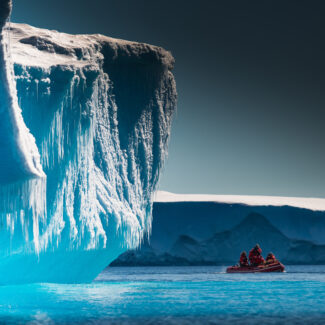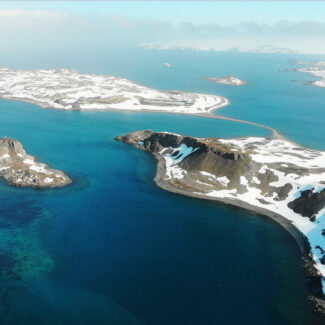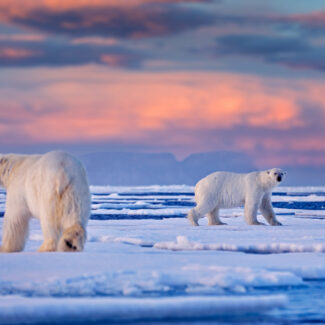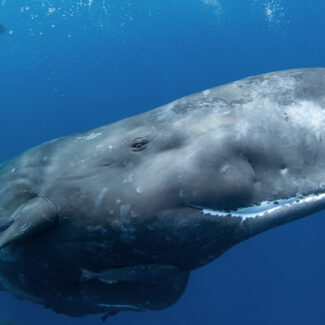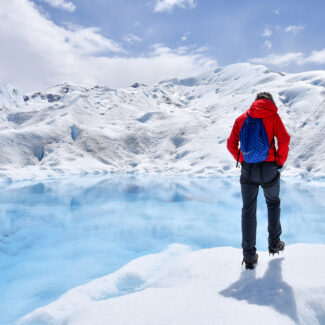Narwhal Facts: Secrets Of The Unicorn Of The Sea Revealed
- (1) Narwhals Are True Arctic Whales
- (2) Narwhals & Belugas Are Closely Related—and Can Hybridize
- (3) The Narwhal Tusk is an Elongated Tooth
- (4) Scientists Still Don’t Fully Understand the Purpose of the Narwhal’s Tusk
- (5) One Theory for the Origin of the Narwhal’s Common Name is on the Morbid Side
- (6) Narwhals Are Deep Divers
- (7) They May Seasonally Form “Super-pods”
- (8) Polar Bears & Orcas Are Occasional Narwhal Hunters
- When & Where to See Narwhals
If the beluga whale is the “sea canary,” the narwhal—another Arctic cetacean, and as it happens a very close cousin—is the “unicorn of the sea.” Indeed, the long tusk wielded (mainly) by male narwhals makes this mid-sized toothed whale’s most distinguishing feature—and marks the sea-unicorn as one of the most unique-looking marine mammals out there.
Growing to between 13 feet (females) and 16 feet (males) and weighing up to 3,500 pounds, narwhals are classified as a species of Least Concern by the International Union for the Conservation of Nature (IUCN), and are hunted on a commercial and subsistence basis in both Canada and Greenland. A 2024 estimate put their global population at about 177,000. The narwhal’s tight association with sea ice—we’ll get into that—and other adaptations to polar living, plus susceptibility to anthropogenic noise and activity, has led scientists to pinpoint it as one of the more vulnerable Arctic animals to climate change.
The chance to potentially spot a narwhal is one of many thrilling wildlife-watching opportunities available on Arctic cruises, particularly in Greenland and the Canadian Arctic Archipelago.
Glimpse the elusive unicorn of the Arctic! With its legendary tusk piercing the icy waves, the narwhal holds secrets of a world few have witnessed.
(1) Narwhals Are True Arctic Whales
Narwhals are endemic to the Arctic: that is, they’re exclusively found there. This puts them in the company of beluga (also toothed whales) and bowhead whales (a baleen whale), other Arctic specialists. Other whales definitely visit the Arctic to take advantage of its rich summer productivity, but migrate southward for winter. The bodies of narwhals, belugas, and bowheads are about 50% body fat, significantly more than the proportions of other cetaceans—one of the prime adaptations for year-round living in cold polar seas.
And narwhals and belugas are the only whales that actually winter out in the pack ice. Narwhals breathe via cracks, leads, and other shifting openings in the sea-ice cover, and often breed out amid the pack in the late winter and early spring. Narwhal calves, born in summer, are proportionately quite hefty: about a third of their mother’s size, which boosts their resilience in chilly waters.
Narwhals, however, are not uniformly distributed in the Arctic Ocean. Their primary stronghold is the eastern Canadian High Arctic, northern Hudson Bay, and Greenland, though their range extends from the central Canadian Arctic Archipelago to Russia’s Franz Josef Land. The Arctic’s Atlantic sector, in other words, is the main stomping-ground of the narwhal. Lone individuals and small groups have occasionally been recorded from Alaskan waters, mainly in the Beaufort Sea but also in the Chukchi Sea and, in a handful of cases, in the Bering Sea (including at the mouth of the Caribou River on the Alaska Peninsula); but this Pacific side of the Arctic—as well as, certainly, such southerly Atlantic zones where the species has periodically been recorded, such as Newfoundland and the British Isles—is mainly considered the realm of rare vagrant narwhals.
Most narwhals do migrate within their year-round Arctic realm, traveling between wintering grounds out in the pack ice to coastal and inshore waters in summer; migration routes may run more than 1,000 miles and often hug the edges of the sea ice. Different narwhal stocks show major fidelity to their respective migratory pathways and winter/summer ranges. The large Baffin Bay narwhal stock, for example, migrates between overwintering grounds in the pack ice of Davis Strait to summer range among the channels, straits, sounds, and fjords of northeastern Canada and Greenland. Barents Sea narwhals, however, don’t utilize the otherwise typical summer coastal realms and instead are associated with deep, offshore, ice-covered waters throughout the year.
A gathering of the Arctic’s mythical unicorns! These narwhals, seen from above in their icy domain, navigate the cold waters with their iconic tusks, a true spectacle of the far north.
(2) Narwhals & Belugas Are Closely Related—and Can Hybridize
Narwhals and belugas are close cousins, the only two members of the Arctic toothed-whale family Monodontidae. Monodontids lack a dorsal fin (though the narwhal does have a notable dorsal ridge) and have bulbous melons and stubby—or, in the case of the narwhal, virtually nonexistent—snouts. This is sometimes called the “white-whale” family, though the beluga is the true white one.
Narwhals and belugas may have diverged approximately five million years ago. They remain kindred enough to periodically hybridize, producing a hybrid that’s been termed a “narluga.”
(3) The Narwhal Tusk is an Elongated Tooth
The narwhal’s famous, spiraling tusk is made of ivory—a composition that made it a highly valued trade item for many centuries in Europe and elsewhere—and represents not a unicorn-like horn but actually an erupted, spectacularly elongated tooth. It’s one of two teeth grown in the whale’s upper jaw; typically it’s the left one that actually pokes through the male’s lip and develops into the mighty tusk, while the right one normally remains embedded. Rarely both teeth erupt, resulting in a double-tusked narwhal. The emergence of the tusk tooth from the male’s jaw usually commences at the age of two or three years old. The tusk may reach nine feet in length, more than half the body length of an adult male narwhal.
As mentioned, it’s the male narwhal that normally wields a tusk, but occasionally females—whose pair of teeth typically remains embedded in the upper jaw—grow them as well. Indeed, even double-tusked females have been spotted here and there.
The mouths of adult narwhals, meanwhile, are toothless; the whales seem to mainly suck in their small prey—fish and squid, primarily—and swallow it whole.
Nature’s remarkable spiral! This elongated tooth, the narwhal’s tusk, has fascinated scientists and storytellers for centuries, unlocking secrets about these elusive Arctic whales.
Source: See page for author, CC BY 4.0 <https://creativecommons.org/licenses/by/4.0>, via Wikimedia Commons
(4) Scientists Still Don’t Fully Understand the Purpose of the Narwhal’s Tusk
People have pondered the purpose of the narwhal’s tusk for many centuries. The proposed functions have ranged from breaking through sea ice and spearing prey to aiding with the cetacean’s breathing. The most prevailing theory has to do with sexual selection, given it’s primarily males that have a tusk; the idea is that the tusk might attract females and intimidate rivals—or be used to actively clash with them. Scarring observed on the heads of male narwhals, broken tusk tips found lodged in their jaws, and frequent observations of males crossing tusks with one another—a behavior called “tusking”—certainly adds weight to the idea that at least one important purpose of the oversized tooth is competition over mates. One study showed a correlation between tusk length and testes mass in male narwhals, indicating that a longer-speared male might be more likely to catch the eye of a female.
The tusk, however, is likely to be more than simply a secondary sexual characteristic. Modern research shows the narwhal tusk to be porous and innervated, with channels and tubules directly connecting the tusk’s interior with seawater. This suggests the tusk may partly be a sensory organ, allowing the narwhal to detect ocean temperature, salinity, and other characteristics.
A 2025 study based on drone footage of narwhals interacting with each other, Arctic char, and glaucous gulls in Nunavut, Canada, suggested the whales may also use their tusks to stun or manipulate prey as well as to tactilely explore, and even to play.
The narwhal’s enigmatic tusk – a subject of scientific curiosity! Even today, the precise purpose of this remarkable feature remains a captivating mystery of the Arctic seas.
Source: NOAA United States. National Marine Fisheries Service, Public domain, via Wikimedia Commons
(5) One Theory for the Origin of the Narwhal’s Common Name is on the Morbid Side
The word narwhal comes from Old Norse or Icelandic, and many authorities translate it to “corpse whale.” That rather creepy moniker, this etymological theory goes, stems from the appearance of the adult narwhal’s hide, which was likened to that of a drowned mariner.
Narwhals are grayish at birth, then darken as they mature. The blackish skin of younger adults develops white mottling as animals age; older adults are often pale with some dark speckling remaining on the dorsal side. That whitish, mottled look explains the whole expired-sailor comparison.
Some references, however, suggest the “corpse-whale” etymology is off-base, and that the name is partly built from nál, or “needle”—a reference instead to the whale’s tusk. The Inuktikut Inuit name for the unicorns of the sea, definitely less grim than corpse whales, also nods to the spearlike tooth: qilalugaq gernertaq, “the Ones Who Point at the Sky.”
(6) Narwhals Are Deep Divers
Narwhals are outstanding divers, regularly plunging to impressive depths—often 400 meters (1,312 feet) to 1,400 meters (4,592 feet), occasionally past 1,800 meters (5,904 feet), which in many parts of their primary Arctic Ocean range takes them down to the seafloor. A number of other cetaceans, including the sperm whale, northern bottlenose whale, and the all-out mammalian diving champion, the Cuvier’s beaked whale, dive deeper—the Cuvier’s beaked whale has been recorded down as far as 2,992 meters (9,800 feet)—but the narwhals is still very much one of the elite deep-sea goers among air-breathing beasts.
Besides their insulating blubber and close-nested arteries and veins in their flippers (also helping with body warmth), they show numerous adaptations for deep-diving, including compressible ribs and rich oxygen-carrying hemoglobin in the blood and myoglobin in the muscle tissue. Narwhals breathe deep at the surface between dives, recharging their systems with oxygen, and expel all the air from their lungs before plunging to avoid a buildup of nitrogen gas in their blood.
Narwhals can spend upwards of a half-hour or so down in the depths. Tracking studies suggest they often flip upside down while cruising near or along the seabed, possibly to allow tusked individuals to disturb the sediment and flush out prey. Speaking of, narwhals feed heavily on benthic (seafloor-associated) fare such as Greenland halibut and northern shrimp; other important prey species include Arctic and polar cod.
A glimpse before the plunge! Narwhals, true deep-sea masters of the Arctic, showcase their tails as they prepare for their remarkable dives into the ocean’s depths.
Source: Gazprom neft, CC BY-SA 4.0 <https://creativecommons.org/licenses/by-sa/4.0>, via Wikimedia Commons
(7) They May Seasonally Form “Super-pods”
Amid the extensive pack ice of winter, narwhal pods are typically on the small side: usually two to 10 or so individuals. But in spring and summer, when migrating to summering range and cruising more extensive open water, narwhals not uncommonly loosely mass together in dispersed “super-pods” of sorts, which can number in the hundreds or even the thousands.
(8) Polar Bears & Orcas Are Occasional Narwhal Hunters
Polar bears are known to occasionally prey on narwhals, primarily when the cetaceans are stranded by high tides and lying helplessly beached. It’s also possible the bears sometimes ambush narwhals, especially younger animals, from the edge of ice floes, as they’ve been known to do with belugas, and maybe opportunistically attack animals trapped—as sometimes happens, given the vagaries of wind and currents—within pack ice.
A more significant narwhal-hunter, identified by both the Traditional Ecological Knowledge of Inuit peoples and the observations of Western scientists, is the ocean’s supreme apex predator: the orca, or killer whale. Orcas are not uncommon in some of the ice-free zones of the narwhal’s summer range, and direct attacks have been documented in the scientific literature. Narwhals under assault by orcas have been seen to cluster together in tight groups, hew close to shore in shallow water and lie still, and even temporarily strand themselves—though killer whales have themselves been witnessed coming close to beaching in order to trap the sea-unicorns against the shoreline.
A stark reality of the Arctic! Here, a powerful polar bear feeds on a narwhal, a dramatic illustration of the challenges faced by these ‘unicorns of the sea’ in their icy world. Source: Fallows C, Gallagher AJ, Hammerschlag N (2013), CC BY 2.5 <https://creativecommons.org/licenses/by/2.5>, via Wikimedia Commons Edited: Converted to b&w
When & Where to See Narwhals
Restricted to the Arctic Ocean—and especially prevalent from the Canadian High Arctic and Greenland eastward to Svalbard and the Russian Arctic—narwhals undergo annual migrations from their wintery range along leads in the offshore pack ice to their preferred summertime sinaaq (“edge of the ice” in Inuktitut) haunts in coastal waters at the floe edge, where landfast ice meets the open Arctic Ocean and species thrive.
It’s this summertime period, between July and September, when they gather in large aggregations in shallow, ice-free coastal bays and fjords that provides the likeliest window for spotting narwhals on Arctic cruises.
Given their range, Arctic cruises to Greenland and the High Arctic of Canada—in particular Northwest Passage cruises exploring Lancaster Sound between Baffin Island and Devon Island in Nunavut (Croker Bay, Tasiujaq, Pond Islet, and Admiralty Inlet are ‘hot’spots)—offer the most promising odds for spotting narwhals in the wild, but they have been known to make surprise appearances on Svalbard cruises.
Zodiac excursions along their favored floe edge are perhaps the optimal pursuit to proffer sightings, with forays into this dynamic environment rich in marine life providing opportunities to see species such as seals, whales, and a variety of seabirds in startling close-up
But we’ll level with you: It’s not all that easy spying the “unicorn of the sea.” Narwhals are notoriously shy, deep-diving, and often widely scattered in small pods. [That’s probably why no narwhal-focused cruises exist currently.] But that just makes glimpsing these small, near-mythical cetaceans in their natural habitat all the more incredible.
Disclaimer
Our travel guides are for informational purposes only. While we aim to provide accurate and up-to-date information, Antarctica Cruises makes no representations as to the accuracy or completeness of any information in our guides or found by following any link on this site.
Antarctica Cruises cannot and will not accept responsibility for any omissions or inaccuracies, or for any consequences arising therefrom, including any losses, injuries, or damages resulting from the display or use of this information.


